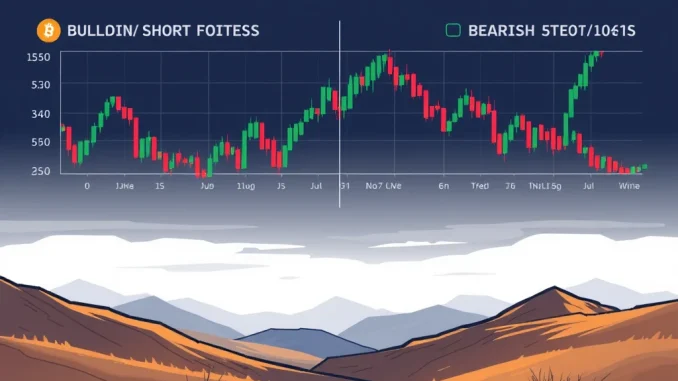
Understanding the pulse of the market is absolutely crucial for anyone involved in BTC perpetual futures trading. One of the most insightful metrics traders watch is the long-short ratio. This simple number reveals how many traders are betting on Bitcoin’s price to go up (long) versus those betting on it to go down (short) on futures exchanges. Monitoring the Bitcoin long short ratio provides a snapshot of prevailing crypto market sentiment, helping traders gauge potential shifts in momentum.
Analyzing the Latest BTC Perpetual Futures Data
Let’s dive into the recent BTC perpetual futures long-short ratios observed across major cryptocurrency exchanges over the past 24 hours. This data gives us a clear picture of the current trading sentiment.
Here’s a breakdown of the ratios:
- Total Aggregate: The overall picture shows longs slightly outweighing shorts.
- Long Positions: 50.32%
- Short Positions: 49.68%
This aggregate number suggests a near-neutral, perhaps very slightly bullish, sentiment across the board for Bitcoin long short ratio on perpetual futures.
A Look at Top Exchanges: Where Does Crypto Long Short Ratio Differ?
While the total ratio is informative, looking at individual exchanges can reveal nuances in trader positioning. Different platforms attract different types of traders, which can lead to variations in the crypto long short ratio.
Here are the ratios for three prominent exchanges:
- Binance: Long 50.34%; Short 49.66% – Very close to the total average, indicating Binance traders largely mirror the overall market sentiment.
- Bybit: Long 49.78%; Short 50.22% – Interestingly, Bybit shows a slight lean towards short positions, differing from the aggregate.
- Gate.io: Long 51.83%; Short 48.17% – Gate.io stands out with a noticeably higher proportion of long positions compared to shorts.
These differences highlight that trading sentiment isn’t uniform across all platforms. While the overall market is balanced, some exchanges show a clearer directional bias.
Interpreting Crypto Market Sentiment from Long-Short Ratios
What can we infer from these crypto market sentiment indicators? A ratio close to 1:1 (50% long, 50% short) generally suggests indecision or a balanced market. A ratio significantly above 1 indicates a dominance of long positions (bullish sentiment), while a ratio below 1 points to more short positions (bearish sentiment).
The current aggregate Bitcoin long short ratio of 50.32% long suggests a slight bullish edge, but it’s very close to neutral. The variations on exchanges like Gate.io (more long) and Bybit (slightly more short) show localized sentiment differences that traders on those platforms might consider.
Why This Trading Sentiment Data Matters
Traders use the trading sentiment derived from these ratios in various ways:
- Confirmation Tool: If the ratio aligns with their own analysis (e.g., they are bullish and the ratio shows more longs), it can confirm their view.
- Contrarian Indicator: Sometimes, an extremely skewed ratio (e.g., overwhelmingly long) can signal a potential reversal, as too many traders on one side might lead to liquidation cascades if the price moves against them.
- Understanding Positioning: It helps gauge potential support or resistance levels based on where large clusters of stop losses or liquidation points might be.
It’s important to remember that the Bitcoin long short ratio is just one data point among many. It should be used in conjunction with technical analysis, fundamental analysis, and other on-chain metrics to form a comprehensive trading strategy for BTC perpetual futures.
Conclusion: A Balanced Picture with Nuances
The latest BTC perpetual futures long-short ratios over the past 24 hours paint a picture of a largely balanced market sentiment overall, with a very slight lean towards long positions. However, examining individual exchanges reveals interesting variations, with Gate.io showing more pronounced bullish sentiment among its traders compared to Bybit’s slight bearish tilt. Keeping an eye on these ratios is a crucial part of understanding the market’s temperature, but always combine this insight with other analytical tools for robust decision-making in your trading sentiment analysis.



